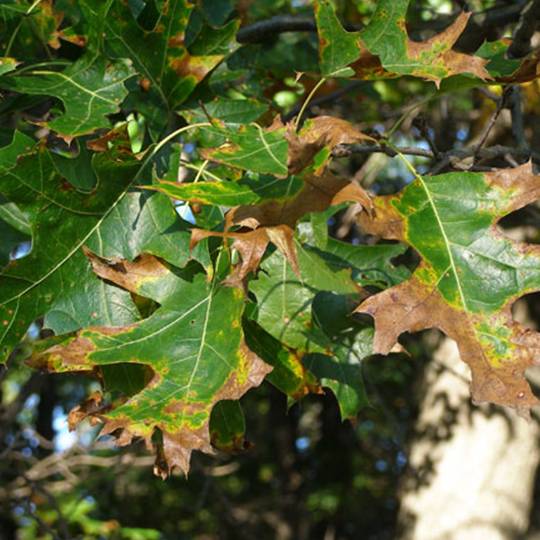History
Oak Wilt was first documented in the 1940s in Wisconsin. However, Canada has just experienced its first detection and losses this year in 2023. There have been three detections: City of Niagara Falls, Township of Springwater, and Town of Niagara-on-the-lake. Since this is relatively “new” for Canada, the Canadian Food Inspection Agency is the federal body spearheading the reporting and containment of Oak Wilt.
Diagnosis
Oak Wilt is a fungal disease caused by the organism Bretziella Fagacearum. It attacks Oak species trees through their xylem (water transport) tissue, gumming up the passageways and inhibiting water transport, which causes the characteristic wilting appearance and decaying of living tissues. It primarily impacts Oaks in the Red Oak genus. A tree might become infected by visiting beetles of the Nitidulid family (carrying spores on their legs), through the root network of an adjacent infected tree, or by humans carrying infected firewood to a new area. Oak Wilt has the potential to live in cut firewood logs for an extended period of time – it is thought to be active for up to 5 years or longer – and can then infect other healthy trees by beetles or spreading of spores via rainwater runoff. Since infected trees’ root systems are proportionate to the size of the tree, and the local Nitidulid beetles do not travel far distances on their own, humans are the biggest spreaders of Oak Wilt from one area to the next.
Identification
Oak Wilt has a few tell-tale signs to identify it; however, it can resemble other non-threatening diseases such as anthracnose, bacterial leaf scorch, or frost damage. It should be confirmed via laboratory testing before making an official confirmation. Once infected by Oak Wilt, the tree will begin exhibiting signs of decline such as browning leaves and dying branches, losing its leaves in the middle of the growing season (spring or summer), and rapid death. Once a tree has died from Oak Wilt, the fungus will begin sprouting sporing mats underneath the surface of the tree’s bark. This will cause the bark to crack and fissure and the spore mats can become visible, with white or black splotches. The infected tree will also have a strong odor often described as wine-like, sour or fermented, or juicy-fruit bubble gum. Suspected Oak Wilt infections should be reported as soon as possible to the Canadian Food Inspection Agency, via their website.
Risks
Oak Wilt is of concern because there is no treatment for it; it can cause the death of a healthy mature oak tree within a single season. Because we have already sustained terrible losses of other hardwood species due to similar fungal diseases (such as Dutch elm disease, Chestnut blight, and Beech bark disease), it is very important that we try to minimize the spread of Oak Wilt as much as possible. In Sarnia, we have a large population of mature Oaks that have been thriving for hundreds of years in our nutrient rich soils. There are many neighborhoods and streets in Sarnia where Oak is the dominant canopy species. If one were to get infected, it would spread to the adjacent trees and beyond, and we could suffer significant losses. Not only would losing our mature canopy take away from the beauty of our land, but it is also very expensive to have those infected/dying/dead trees removed and processed. Substantial tree loss would have a negative impact on our community. Homeowners would see the costs of heating and cooling go up as there is no protection and insulation from their mature trees, no more root system to absorb and retain rainwater in their yards and streets, no more roots to retain the soil of our shoreline and impede erosion, and it would mean a loss of habitat and food for our local wildlife. At the very worst, when a mature tree dies suddenly, all that weight is no longer appropriately supported by the wood tissues, which could lead to catastrophic failures on to homes, cars, roadways and even people.
Recommendations
To mitigate the spread of Oak Wilt, it is important to report all suspected infections to the CFIA as soon as possible. If you are not comfortable with assessing a tree or are unsure about the signs and symptoms, you can always reach out to your local arborist and have them assess the tree in question first. It is also important to not have your oak trees trimmed or removed during the growing season (April – November) as this is when the Nitidulid beetles are more apt to visit sap-producing trees. If a tree must be pruned or removed during this time, all cuts and the stump must be painted over to discourage Nitidulid beetles. It is imperative that firewood not be moved between locations, as this is the likeliest transportation of infected material and new infections. Fortunately, the natural spread of Oak Wilt is slow-moving. Equipped with knowledge and preventative measures, we can reduce the risk of Oak Wilt in our community.

About the Author: Ashley is an arborist at Wyoming Tree Service, specializing in plant health care. She is a graduate of the Forestry Technician and Arboriculture programs at Fleming College and is a licensed exterminator who works with both landscape and forestry pesticides.


